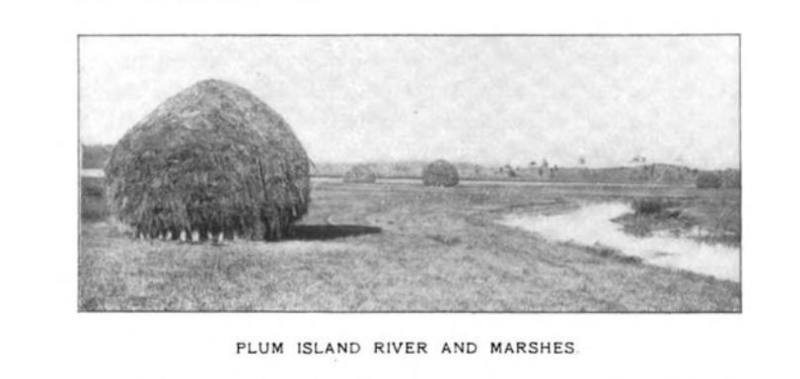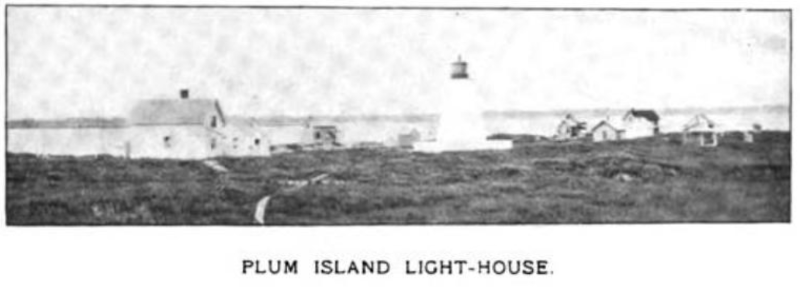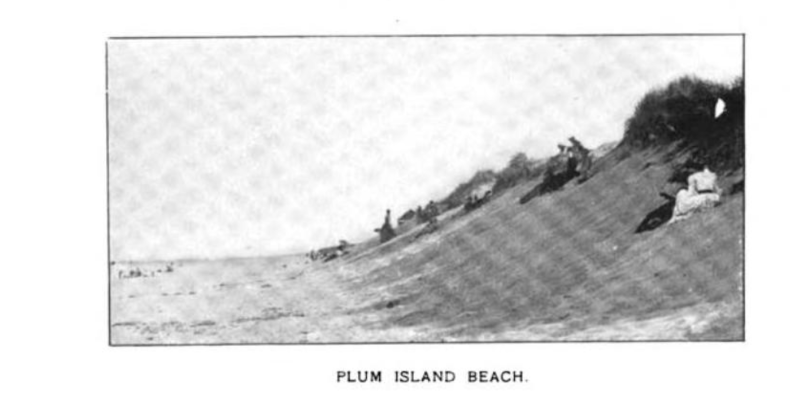Plum Island is a barrier island near Newburyport, Massachusetts. It was first settled in the early 17th century and was shared by the towns of Newbury, Rowley and Ipswich, Massachusetts.
The following is a history of Plum Island:
1605:
- In the summer, French explorer Samuel de Champlain sails by Plum Island while heading south from Nova Scotia to explore the Massachusetts coast. He returns again the following year during another expedition trip.
1614:
- Plum Island is observed and possibly visited by Captain John Smith while he is exploring New England and he later describes it in his book, A Description of New England, as “an Isle of two or three leagues in lengths; the one half, plain moorish grass of mulberry trees gardens: and there is also oaks, pines, and other woods to make this place an excellent habitation, being a good and safe harbor.”
1622:
- On August 10, the Council of New England grants all the land between the Merrimack River and the Kennebec River, including all of the islands within five miles of the shore, to Captain John Mason and Sir Fernando Gorges. As a result, Plum Island is named Mason’s Island but Mason never acts on the grant nor settles on the island.
1635:
- During the 1630s, the island is under the jurisdiction of the Massachusetts Bay Colony and it is named Plum Island due to the abundance of beach plums growing there.
- After a settlement is established at Newbury, the General Court of Massachusetts rules that Newbury, Ipswich and Rowley must share use of Plum Island and its valuable resources such as the salt marsh hay and wildlife.
1649:
- On October 17, the General Court officially divides Plum Island among Ipswich, Newbury and Rowley.
1739:
- The General Court passes an act that makes it unlawful to let livestock roam free on the island due to overgrazing.
1752:
- The first building is constructed on the island when the town of Newbury builds a house for its own use.
1769:
- A pest house, which is a contagious disease hospital, is built on Plum Island near the northern end of the island.
1776:
- During the American Revolution, a fort is built on the northern end of Plum Island and is named Fort Philip. It also serves as a fort during the War of 1812 but later washes away in the 1830s.
1783:
- A lighthouse is built on the island at the mouth of the Merrimack River and is funded by private contributions from the merchants of Newburyport.
1786:
- The lighthouse is destroyed by a storm and the federal government decides to build two new lighthouses on Plum Island to replace it.
1787:
- The Newburyport Marine Society builds two small relief huts on the island, supplied with heavy blankets, cooking utensils and other items, for shipwrecked crews to use due to the increasing number of shipwrecks on the island.
1788:
- The Newburyport Harbor Light, a small wooden lighthouse also known as the Plum Island Light, is constructed on Northern Boulevard and another small wooden lighthouse is also constructed at the entrance of the Merrimack River on the island.
- In December, a small sloop is wrecked on Plum Island during a severe snow storm.
1790:
- The lighthouses on Plum Island are ceded to the federal government.
1804:
- The Merrimack Humane Society builds three additional relief huts on the island for shipwrecked crews. The huts are frequently vandalized though and are in need of repair as a result.
1805:
- In early October, the sloop, Blue Bird, wrecks on Plum Island near the lighthouse.
1806:
- The Plum Island Turnpike and Bridge Corporation receives permission to build a turnpike and a bridge over the Plum Island River.
- The turnpike and bridge are completed in 1807.
- The Plum Island Hotel is constructed near what is now the corner of the Plum Island Turnpike and Northern Boulevard.
1827:
- The town of Newbury sells its portion of the island, about 600 acres, to Moses Pettingell for $600.
1829-31:
- A breakwater, a stone structure designed to protect against waves and storm surges, is constructed at the mouth of the Merrimack River and extends from Plum Island to Woodbridge Island. The breakwater is ineffective and is later destroyed by the waves.
1837:
- On November 2, the schooner Lombard wrecks on Plum Island about a half mile south of the lighthouse. The captain is rescued but the crew is washed overboard.
1839:
- On November 5, the schooner Rebecca is wrecked on the south breaker and the crew is rescued.
- On December 23, the brig Pocahontas is wrecked about half a mile east of the Plum Island Hotel. The captain and crew perish and their bodies are later found on the beach.
- On December 30, seven of the Pocahontas crew members are buried in the Old Hill Burying Ground in Newburyport and a marble monument to them is erected at the cemetery gate.
1844:
- On September 30, the schooner Frederick Reed is wrecked on the island and the captain and crew are rescued.
1847:
- On August 6, the schooner Augusta is wrecked on the beach during a severe gale. The captain and crew are rescued.
1849:
- On December 3, the schooner Nancy is wrecked on the south end of the island and the captain and crew drown. The bodies of the captain and two crew members are found on the beach a few days later.
1850:
- On December 24, the schooner Argus is wrecked near Emerson’s rocks on the south end of the island. The captain is rescued but most of the crew either drown or die of exposure. Several of the bodies are later recovered and buried at the First Presbyterian meeting-house on Federal street in Newburyport.
1851:
- On April 15, the brig Primrose is wrecked on the beach and the captain and crew are all rescued.
1858:
- On January 8, the schooner Sunbeam is wrecked on the beach near the north breaker. The captain drowns but the crew is rescued.
1860s – 1870s:
- Due to dramatically shifting sand bars at the mouth of the Merrimack River during this time period, the remaining lighthouse is moved in 1874 because it is now too far away from the shore.
1867:
- On July 5, the schooner E.A. Creed is wrecked on a sand bar on the island while attempting to enter Newburyport harbor during a thunderstorm. The captain and crew are rescued.
- On July 21, the schooner Olive Branch is wrecked at Sandy Beach on the island and one crew member is mortally wounded in the accident.
1874:
- The first United States life saving station is built on Sandy Beach and is later moved closed to Lighthouse point in 1881. Nearly 100 shipwrecks occur on the island after 1874.
1875:
- On November 10, the schooner Lacon is wrecked on the beach near the north breaker.
1877:
- On March 31, the schooner Flying Fish and the schooner Queen of the Bay is wrecked on a sand bar on the island. The captain and crew survive.
- On July 1, the schooner Anna Maria also wrecks on the sand bar and the captain and crew are rescued.
1881:
- The first summer cottage, the Simpson House, is constructed on the island.
1883:
- On May 21, the steamer City Point is wrecked near Emerson’s rocks and the captain and crew are rescued.
1885:
- On October 13, the schooner Virginia wrecks on the beach.
1886:
- On February 10, the fishing schooner Lizzie H. Haskell wrecks on the beach.
- On April 6, the schooner Beta wrecks on the north breaker and one man and three children drown in the accident.
- On November 13, the schooner Franklin and the schooner Carrie H. Spofford wreck on the beach near the life saving station.
1887:
- On November 3, the schooner John F. Sanford wrecks near the north breaker.
1889:
- On December 5, the schooner Hannah Stone wrecks near the north breaker and the captain and crew are rescued.
1891:
- On August 19, the schooner Lucy M. Collins wrecks near the south end of Plum Island.
- On December 6, the schooner M.I. Wetherell wrecks near Lighthouse point.
1893:
- On May 4, the schooner Brave wrecks near the life saving station at Knobb’s Beach. The captain and three crew members drown in the accident.
1895:
- On June 30, the schooner Mary G. Powers is beached on Plum Island and the captain and crew are rescued.
- On July 4, the schooner Abbie and Eva Hooper is beached near the life saving station and the captain and crew are rescued.
1896:
- On February 6, the schooner Alianza, wrecks near the life saving station.
1898:
- The Newburyport Harbor Lighthouse, also known as the Plum Island Light, is rebuilt on Northern Boulevard.
1899:
- On December 23, a small steamer, Laura Marion, wrecks on the sand bar while attempting to enter Newburyport harbor during heavy seas.
1902:
- On May 25, the steamer Globe is beached on the sand bar and the captain and crew are rescued.
- On July 1, the United States Life Saving Station changes its name to the Newburyport Life Saving Station.
1904:
- On August 15, the schooner Edwina is temporarily beached on Plum Island but does not sustain any damage.
1905:
- On October 21, the schooner Shenandoah is temporarily beached near the life saving station but does not sustain any damage.
1906:
- On February 3, the sloop Fortuna is temporarily beached near the south end of Plum Island but does not sustain any damage.
1910:
- In mid-March, after a successful biplane test flight in nearby Essex, naval architect W. Starling Burgess and his crew builds a wooden “runway” on the marshes at Plum Island, near what is now the Plum Island Airfield, to conduct flight trials.
- On April 17, Burgess and Augustus M. Herring make a series of short flights with a rear engine biplane, the H-B #2 on Plum Island.
1914:
- On May 14, 1914, the Plum Island Hotel is destroyed in a fire.
1920:
- On July 30, the Plum Island Beach Company purchases the Newbury section of Plum Island from the Pettingell family. Shortly after, the company builds Northern Boulevard on the land, installs electricity, divides the land into lots and offers them for sale to the public.
1922-25:
- Sometime between 1922 and 1925, a house is built at 60 Plum Island Turnpike, which is now known as the Pink House.
1926:
- The area that is now known as the Plum Island Airfield was designated an emergency landing field by the U.S. Army Air Service.
1930s:
- In the early 1930s, the Massachusetts Audubon Society purchases 1,500 acres of land on the island and establishes a bird sanctuary.
1940:
- The Plum Island Airfield is constructed on the Plum Island Turnpike.
1941:
- A ban on private flying in a Coastal Defense Zone forces the Plum Island Airfield to temporarily close.
- The U.S. Fish and Wildlife Service purchases the bird sanctuary and adds around 3,000 acres of land to establish the Parker River Wildlife Refuge. The refuge now covers all of the original Rowley and Ipswich owned sections of the island and part of the Newbury section.
1945:
- The Plum Island Airfield reopens after WWII ends.
1978:
- On February 6-7, the Blizzard of ’78 hits New England causing hurricane-force winds and massive flooding on Plum Island and prompts an evacuation of the island.
2001:
- Local lobsterman Bob Hartigan and his wife Joyce open a restaurant and seafood market on the Plum Island Turnpike called Bob Lobster.
2013:
- On February 8, the Blizzard of 2013, also known as Winter Storm Nemo, hits New England and causes flooding and erosion on Plum Island.
- In early March, two houses on Annapolis Way collapse into the ocean and 12 houses are condemned after the Blizzard of 2013 renders them structurally unstable due to erosion.
2015:
- Amid community concerns that the Parker River National Wildlife Refuge might demolish the Pink House, which is located on the refuge, a group is founded to advocate for the preservation of the house.
Sources:
Currier, John James. Ould Newbury: Historical and Biographical Sketches. Damrell and Upham, 1896.
Currier, John J. History of Newburyport, Mass. 1764 – 1909. vol II, Printed for the author, 1909.
Duda, Rebecca A. “At the Mouth of the Merrimack – Plum Island.” Discovering the Historic Merrimack Valley, Lowell Sun, 1 Aug. 2016, blogs.lowellsun.com/history/2016/08/01/at-the-mouth-of-the-merrimack-plum-island/
“Bob Lobster.” Newburyport.com, newburyport.com/restaurant/bob-lobster/
“Plum Island Home Falls Into Ocean, Several Others Threatened.” Boston 25 News, 8 March. 2013, boston25news.com/news/plum-island-home-falls-into-ocean-several-others-threatened-2/139791646/
Luna, Marcos. “Column: Blizzard of ’78 and Lessons Learned.” Salem News, 6 Feb. 2018, salemnews.com/opinion/columns/column-the-blizzard-of-78-and-lessons-learned/article_0a582c96-8908-5195-9569-3278be9a113a.html
“NWB.918 Newburyport Harbor Light.” MACRIS, Massachusetts Cultural Resource Information System, mhc-macris.net/#!/details?mhcid=NWB.918
“New.F Plum Island Community Airfield.” MACRIS, Massachusetts Cultural Resource Information System, mhc-macris.net/#!/details?mhcid=NEW.F
“Plum Island.” Newbury Historical Society, newbury1635.org/plum-island.html





I was in the 101st Combat Engineers of the Massachusetts National Guard on Low St during the Blizzard of ‘78 and participated in the evacuation of Plum Island. The National Guard had the only vehicles that could cross the Plum Island Bridge during the storm because the Plum Island River was extremely high on both ends of the bridge. As we drove north up Plum Island Boulevard, going house to house to evacuate people we had to avoid a huge iceberg that had been thrown by the storm over the sand dunes and into the middle of the road after it smashed through a small wooden cottage. All the Guardsmen were soaked up to the waist from going house to house. Believe it or not, not everyone chose to be evacuated. Those that did, climbed.up and into the back of the six wheel drive, deuce and a half trucks and we drove them to the Armory on Low St. It was a long, cold, wet and miserable day. And one I’ve not forgotten. I was 22 years old.
Thank you for your story Timothy! That sounds terrifying. My dad was also a part of the rescue team that evacuated Plum Island but he wasn’t in the National Guard. He was a snow plow driver and I don’t know if he volunteered or was asked to drive there and rescue people in his snow plow but he did. He also said some people refused to leave and he had to leave them there. He nearly fell of the Plum Island Turnpike into the water during a white out and had to stop and wait for a moment until he could see again.